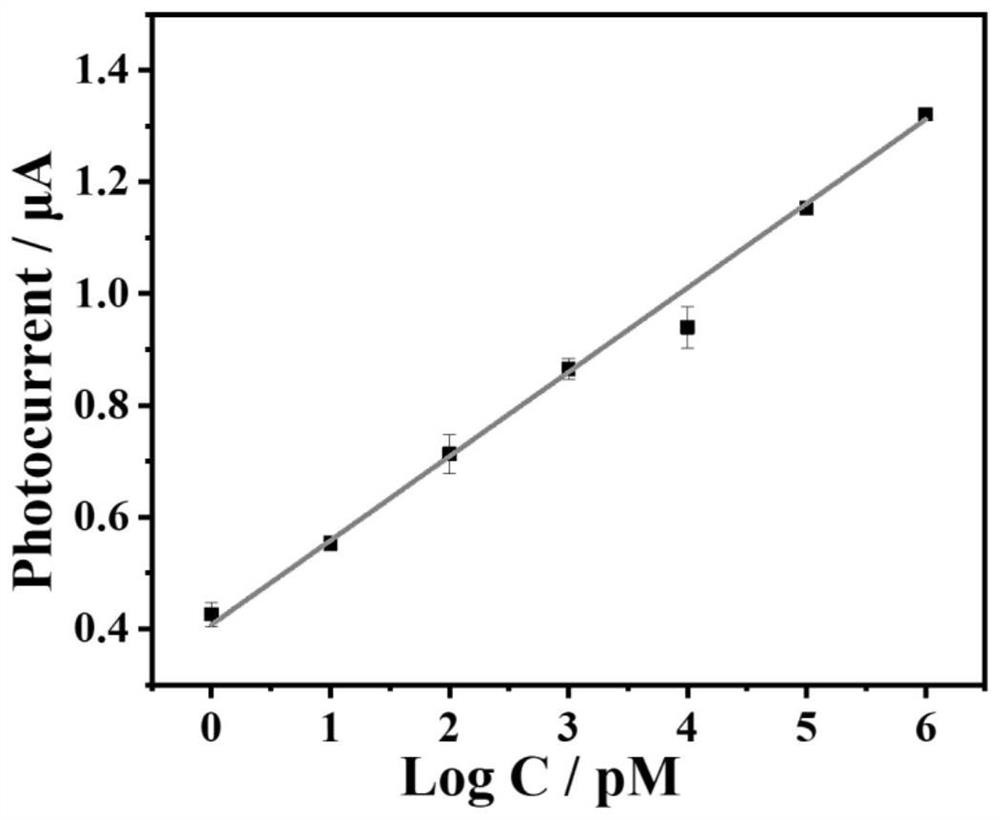Preparation method and application of photoelectrochemical biosensor for detecting oxytetracycline
A biosensor and photoelectrochemical technology, applied in the field of biosensors, can solve the problems of time-consuming and extensive use, false positives, expensive equipment, etc., and achieve the effects of improving detection performance, increasing selectivity, and high sensitivity
- Summary
- Abstract
- Description
- Claims
- Application Information
AI Technical Summary
Problems solved by technology
Method used
Image
Examples
Embodiment 1
[0031] according to figure 1 Described preparation process:
[0032] (1) Preparation of CN nanomaterials:
[0033] Melamine (2 g) was ground in an agate mortar for 10 min, then placed in an alumina crucible and heated at 500°C for 4h at a ramp rate of 2.3°C / min. After cooling to room temperature in air, the resulting CN powder was collected;
[0034] (2) Bi 2 S 3 - Preparation of CN heterojunction:
[0035] Put Bi(NO 3 ) 3 ·5H 2 O (1.82 g) was dissolved in ethylene glycol (25 mL), followed by Na 2 S·9H 2 O (1.35 g) was dissolved in 30 mL of ultrapure water, then Na 2 S·9H 2 O solution was added dropwise to Bi(NO 3 ) 3 ·5H 2O solution. The CN (12.5 mg) powder prepared in (1) was added rapidly and stirred for 30 min. After stirring, it was transferred to a Teflon-lined autoclave and put into a vacuum drying oven to react at 160 °C for 12 h, and the autoclave was cooled down to room temperature naturally. 2 S 3 -CN heterojunction precipitation, alternately washe...
Embodiment 2
[0040] (1) Preparation of CN nanomaterials:
[0041] Melamine (2 g) was ground in an agate mortar for 10 min, then placed in an alumina crucible and heated at 500°C for 4h at a ramp rate of 2.3°C / min. After cooling to room temperature in air, the resulting CN powder was collected;
[0042] (2) Bi 2 S 3 - Preparation of CN heterojunction:
[0043] Put Bi(NO 3 ) 3 ·5H 2 O (1.82 g) was dissolved in ethylene glycol (25 mL), followed by Na 2 S·9H 2 O (1.35 g) was dissolved in 30 mL of ultrapure water, then Na 2 S·9H 2 O solution was added dropwise to Bi(NO 3 ) 3 ·5H 2 O solution. Quickly add the CN (20mg) powder prepared in (1) and stir for 30min; after stirring, transfer it to a Teflon-lined autoclave and put it into a vacuum drying oven to react at 160°C for 12h, etc. The autoclave was cooled to room temperature naturally, and the Bi 2 S 3 -CN heterojunction precipitation, alternately washed 3 times with ultrapure water and absolute ethanol to remove impurities an...
Embodiment 3
[0048] (1) Preparation of CN nanomaterials:
[0049] Melamine (2 g) was ground in an agate mortar for 10 min, then placed in an alumina crucible and heated at 500°C for 4h at a ramp rate of 2.3°C / min. After cooling to room temperature in air, the resulting CN powder was collected;
[0050] (2) Bi 2 S 3 - Preparation of CN heterojunction:
[0051] Put Bi(NO 3 ) 3 ·5H 2 O (1.82 g) was dissolved in ethylene glycol (25 mL), followed by Na 2 S·9H 2 O (1.35 g) was dissolved in 30 mL of ultrapure water, then Na 2 S·9H 2 O solution was added dropwise to Bi(NO 3 ) 3 ·5H 2 O solution. The CN (25 mg) powder prepared in (1) was added quickly and stirred for 30 min. . After stirring, it was transferred to a Teflon-lined autoclave and put into a vacuum drying oven to react at 160 °C for 12 h, and the autoclave was cooled down to room temperature naturally. 2 S 3 -CN heterojunction precipitation, alternately washed 3 times with ultrapure water and absolute ethanol to remove ...
PUM
| Property | Measurement | Unit |
|---|---|---|
| diameter | aaaaa | aaaaa |
Abstract
Description
Claims
Application Information
 Login to View More
Login to View More - R&D
- Intellectual Property
- Life Sciences
- Materials
- Tech Scout
- Unparalleled Data Quality
- Higher Quality Content
- 60% Fewer Hallucinations
Browse by: Latest US Patents, China's latest patents, Technical Efficacy Thesaurus, Application Domain, Technology Topic, Popular Technical Reports.
© 2025 PatSnap. All rights reserved.Legal|Privacy policy|Modern Slavery Act Transparency Statement|Sitemap|About US| Contact US: help@patsnap.com



